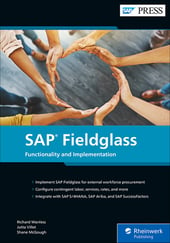The integration between SAP Fieldglass and SAP S/4HANA enables companies to seamlessly integrate the procurement and management of the external workforce into their resource planning.
This ensures high-level cost management of transactions and holistic transparency across procurement categories.
SAP is probably best known for having developed comprehensive enterprise resource planning (ERP) solutions. ERP systems are used to plan, control, and manage resources, including classic materials management, production planning, financials, and human resources. SAP S/4HANA is SAP’s latest generation ERP system and the core of the intelligent enterprise to digitize supply chains.
SAP S/4HANA enables companies to host master data, business processes, and procurement, as well as a classic ERP system. A new feature of this solution is that, in addition to the classic applications of an ERP system, future technologies such as artificial intelligence (AI), machine learning, blockchain, or SAP Intelligent Robotic Process Automation are integrated. In addition, you can extend SAP S/4HANA with supplementary processes and applications; for example, SAP SuccessFactors, SAP Ariba, SAP Concur, and SAP Fieldglass.
SAP Fieldglass is a cloud-based system that can seamlessly fit into the transactional processes of SAP S/4HANA using productized integrations. It captures the external worker’s spend in SAP Fieldglass through the contingent or statement of work (SOW) process modules. In SAP S/4HANA, spend is tracked through procurement integration (creation of purchase requisition and purchase order), entry of service entry sheets, and an invoice integration. The benefits of integration are obvious: holistic tracking of supply chains, spend, and invoices, as well as automation and analysis of company-wide spend across procurement categories.
Productized Integrations: Overview
SAP Fieldglass provides a set of standard connectors that can be used to transfer time sheets and expense sheets of external workers, as well as characteristics of SOW contracts to various finance and ERP systems. Specific predefined, productized integrations between SAP Fieldglass and SAP S/4HANA are also available as part of the SAP landscape. They are designed to enable customers to leverage standardized integrations without much effort and to transfer billable items from SAP Fieldglass to SAP S/4HANA. The integrations between SAP Fieldglass and SAP S/4HANA are divided into three categories:
- Replication of master data from SAP S/4HANA to SAP Fieldglass
- Replication of business partner/vendor data from SAP S/4HANA to SAP Fieldglass
- Creation of transactional objects from SAP Fieldglass to SAP S/4HANA, including purchase requisitions, purchase orders, service entry sheets, and invoices
Master Data and Business Partner Data
The integration of master data is a one-way flow in which the master data is replicated from SAP S/4HANA to SAP Fieldglass, where the company structure is created. Productized integrations between SAP Fieldglass and SAP S/4HANA use the standard upload and download connectors and data transfer options for each integration point. In SAP S/4HANA, the data replication framework is used to extract the required data and provide it in comma-separated values (CSV) format, which in turn can be used in SAP Fieldglass. In SAP Fieldglass, the standard connectors for uploading master data are used to receive the extracts from SAP S/4HANA and to create and maintain the objects in the system.
For the replication of business partners, the data replication framework is used again in the SAP S/4HANA interface. In this case, both business partner and business partner relationship data are extracted from SAP S/4HANA. These are addressed by SAP Fieldglass using specially developed XML formats to populate the fields of the vendor master table. Both master data and business partner replication are available as direct connectivity integration, which communicates directly between SAP S/4HANA and SAP Fieldglass, and as mediated connectivity via SAP Integration Suite.
Transactional Data
After the master data has been created in the company structure and is identical in both systems, you can set up the transactional process flow. The supplier data (business partner data) and master data aligned between the two systems provide the basis for seamless integration of the transactional objects that are created in SAP S/4HANA. The main financial objects supported by these integrations are as follows:
- Purchase requisition
- Purchase order
- Service entry sheet
- Invoice
Each transactional integration point is a bidirectional data exchange between SAP Fieldglass and SAP S/4HANA so that the results of approvals and processing that take place in SAP S/4HANA can be reflected in SAP Fieldglass.
Methods for Integration
The preferred method of communication between SAP Fieldglass and SAP S/4HANA is a mediated connectivity where a middleware such as SAP Integration Suite, SAP Process Integration/SAP Process Orchestration, or a third-party product is used. In these configurations, the default formats of the two systems can be used in each system with minimal additional configuration, as transformations and mappings are processed in the middleware.
For SAP Integration Suite, predefined iFlows have been developed to keep the configuration as simple as possible. These iFlows already contain the necessary transformations and logic for communication between the systems. To execute them, only the endpoints need to be configured. If you use other third-party providers, it may be necessary to create the transformations in this middleware. It’s recommended to use the mediated connectivity method for all integrations, even though the direct option is available for some. This gives you greater access security for the SAP S/4HANA system while providing the benefits of a single point of access for all integration monitoring and error handling.
SAP Integration Suite
You can use the SAP Integration Suite to connect cloud-based applications (e.g., SAP Fieldglass) with other, non-SAP and SAP applications (e.g., SAP S/4HANA). SAP Integration Suite is a PaaS and acts like middleware, where you can configure and customize application programming interfaces (APIs) and OData according to your needs. You can access prebuilt, productized integration packages on SAP API Business Hub at https://api.sap.com.
Summary
The integration possibilities between SAP Fieldglass and SAP S/4HANA are very popular because they increase your budget accuracy and improve your invoicing process. They also enable you to leverage the additional procurement data and analytics in the intelligent enterprise. Aligned master data and business partner information is a prerequisite for using the integrations that include purchase requisitions and purchase orders, as well as (optional) service entry sheet and invoice information.
This post was originally published 7/2022.




Comments